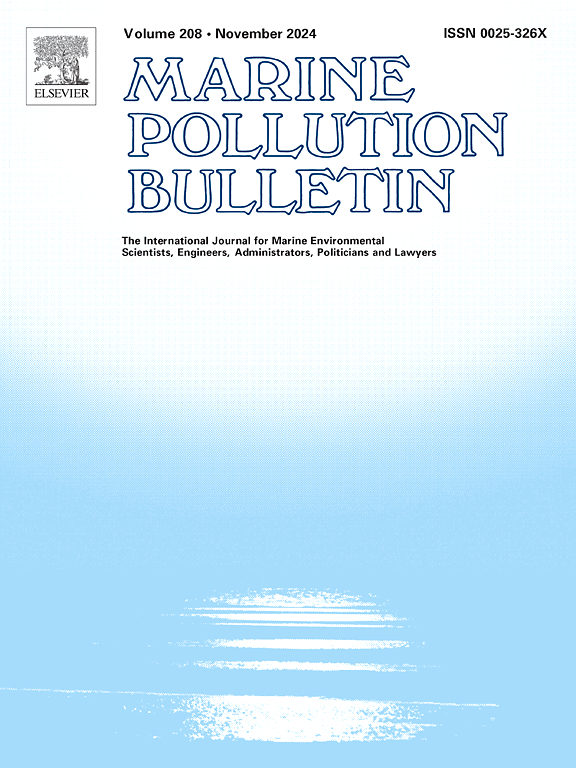MABI:基于色彩空间转换的新型混合藻华指数
IF 5.3
3区 环境科学与生态学
Q1 ENVIRONMENTAL SCIENCES
引用次数: 0
摘要
有害藻华(HABs)对沿海经济和生态系统构成严重威胁,但由于藻华类型多样,环境条件复杂,有效监测仍具有挑战性。本文提出了一种混合藻华指数(MABI),利用一种新的色彩空间来改进有害藻华的检测。通过使用哨兵-2 的近红外、短波红外和绿色波段来计算三基色值(取代传统的 RGB 波段),MABI 显著提高了藻华与水的区分度。此外,还利用改进的基于网格的大津自动阈值分割算法来提取藻华。采用类间距离作为指标来比较 14 个常用的藻华指数。在全球 9 个地点(包括沿海和内陆地区)进行的验证表明,MABI 具有很强的鲁棒性,总体准确率为 0.98,Kappa 系数为 0.95。与传统的藻华指数相比,所提出的藻华指数在检测藻华方面具有显著优势,既能有效识别多种藻类的混合藻华,也能有效识别单一藻类的藻华。我们还利用 Landsat-8 验证了 MABI 的有效性,Landsat 和 Sentinel-2 图像的结合有望增强 MABI 监测藻华整个生命周期的能力。虽然 MABI 对薄云和阴影有一定的抵抗能力,但在光学复杂的水域,其探测精度仍会受到影响。因此,建议谨慎选择阈值或结合其他指数进行综合评估。本研究利用谷歌地球引擎(GEE)进行数据采集、处理、算法开发和验证,为准确监测藻华提供了高效可靠的工具,应用范围十分广泛。本文章由计算机程序翻译,如有差异,请以英文原文为准。
MABI: A novel Mixed Algal Blooms Index based on color space transformation
Harmful algal blooms (HABs) pose serious threats to coastal economies and ecosystems, yet effective monitoring remains challenging due to diverse bloom types and complex environmental conditions. This paper proposes a Mixed Algal Blooms Index (MABI) that uses a new color space to improve HABs detection. By employing Sentinel-2's near-infrared, short-wave infrared, and green bands to calculate tristimulus values—replacing traditional RGB bands—MABI significantly enhances the distinction between algal blooms and water. And an improved grid-based Otsu automatic threshold segmentation algorithm is utilized to extract algal blooms. The inter-class distance is employed as an indicator to compare 14 commonly used algal blooms indices. Validation across nine global sites, covering coastal and inland areas, shows MABI's robustness, with an overall accuracy of 0.98 and a Kappa coefficient of 0.95. Compared to traditional algal bloom indices, the proposed MABI shows notable advantages in detecting blooms, effectively identifying both mixed blooms from multiple algae species and single-species blooms. We also verified the effectiveness of MABI with Landsat-8, and the combination of Landsat and Sentinel-2 imagery is expected to enhance its capability to monitor the full lifecycle of algal blooms. While MABI shows some resistance to thin clouds and shadows, its detection accuracy can still be affected in optically complex waters. Therefore, careful threshold selection or combining with other indices is recommended for comprehensive assessment. This study utilized Google Earth Engine (GEE) for data acquisition, processing, algorithm development, and validation, offering an efficient and reliable tool for accurately monitoring HABs with wide-ranging applications.
求助全文
通过发布文献求助,成功后即可免费获取论文全文。
去求助
来源期刊

Marine pollution bulletin
环境科学-海洋与淡水生物学
CiteScore
10.20
自引率
15.50%
发文量
1077
审稿时长
68 days
期刊介绍:
Marine Pollution Bulletin is concerned with the rational use of maritime and marine resources in estuaries, the seas and oceans, as well as with documenting marine pollution and introducing new forms of measurement and analysis. A wide range of topics are discussed as news, comment, reviews and research reports, not only on effluent disposal and pollution control, but also on the management, economic aspects and protection of the marine environment in general.
 求助内容:
求助内容: 应助结果提醒方式:
应助结果提醒方式:


